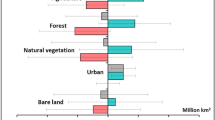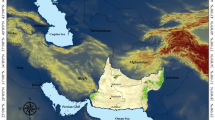Abstract
Presented are the results from taking an inventory and analyzing the land cover transformation during 2001–2012. The study revealed 246 types of transitions between land cover classes according to the International Geosphere-Biosphere Programme, including 229 types of changes with a change of land cover classes. The density of changes is highest in the taiga and steppe zones of Eurasia and North America, savannas and woodlands of Africa and South America, the Arctic tundras of North America and Eurasia. It was found that the natural zones with a complex structure of land cover (open woodlands, shrublands and savannas of the tropical belt and hard-leaved summer-dry open woodland and shrublands of the subtropical belt) have the largest number of transition types (17) and types of changes (10 and 8, respectively). The contribution from the particular transformation processes to the structure of land cover changes within the natural zones was calculated to show the principal land cover trajectories for each natural zone. The findings provide a means of assessing the degree and nature of land cover transformation within the natural zones and identifying, on this basis, the leading land use trends which would have a considerable influence on the structure and dynamics of present-day land surface landscapes across the globe.
Similar content being viewed by others
References
World Map of Present-Day Landscapes Sc 1:15 000 000, With Explanatory Note, E.V. Milanova, A.V. Kushlin and N.J. Middleton, Eds., Moscow: Soyuzkarta, 1993.
Lands of the World: The 1:15 000 000 Map for Universities, L.F. Yanvareva, Ed., Moscow: Kartografiya, 1986 [in Russian].
Bartholomé, E. and Belward, A.S., GLC2000: A New Approach to Global Land Cover Mapping From Earth Observation Data, Int. J. Remote Sens., 2005, vol. 26, issue 9, pp. 1959–1977.
Ecosystems and Human Well-being: Synthesis, Series: Millennium Ecosystems Assessment, J. Sarukhán and A. Whyte, Eds., Washington: Island Press, 2005.
Alekseeva, N.N., Klimanova, O.A. and Khazieva, E.S., Global Land Cover Data Bases and Their Prospects for Present-Day Landscape Mapping, Izv. Akad. Nauk, Ser. Geogr., 2017, no. 1, pp. 110–123 [in Russian].
Herold, M., Mayaux, P., Woodcock, C.E., Baccini, A., and Schmullius, C., Some Challenges in Global Land Cover Mapping: An Assessment of Agreement and Accuracy in Existing 1 km Datasets, Remote Sens. Environ., 2008, vol. 112, issue 5, pp. 2538–2556.
Jansen, L.J.M., Thematic Harmonisation and Analysis of Nordic Data Sets Into Land Cover Classification System LCCS Terminology, Developments in Strategic Landscape Monitoring for the Nordic Countries, G.B. Groom, Ed., Copenhagen: Nordic Council of Ministers, 2004, APN, vol. 705, pp. 91–118.
Herold, M., Latham, J.S., Di Gregorio, A. and Schmullius, C.C., Evolving Standards in Land Cover Characterization, J. Land Use Sci., vol. 1, issue 2–4, pp. 157–168.
Chandra, G., Zhiliang, Z. and Bradley, R., A Comparative Analysis of the Global Land Cover 2000 and MODIS Land Cover Data Sets, Remote Sens. Environ., vol. 94, issue 1, pp. 123–132.
DIScover Land Cover. URL: http://glcf.umd.edu/data/lc/(Accessed Feb. 11, 2017).
Global Land Cover 2000. URL: http://forobs.jrc. ec.europa. eu/products/glc2000/glc2000.php (Accessed Feb. 11, 02.2017).
GlobCover. URL: http://due.esrin.esa.int/page_ globcover. php (Accessed Feb. 11, 2017).
Boori, M.S. and Voženílek, V., Remote Sensing and Land Use/Land Cover Trajectories, J. Geophys. Remote Sens., 2014, vol. 3, issue 3. URL: https://www. omicsonline.org/open-access/remote-sensing-and-landuseland-cover-trajectories-2169-0049.1000123.pdf (Accessed Feb.10, 2017).
Kumar, S., Merwade, V., Suresh, P., Rao, C., and Pijanowski, B.C., Characterizing Long-Term Land Use/Cover Change in the United States from 1850 to 2000 Using a Nonlinear Bi-analytical Model, Ambio, 2013, vol. 42, issue 3, pp. 285–297.
Geographical Belts and Zonal Types of Landscapes: Map, Sc 1:15 000 000, E.N. Lukasheva, Ed., Moscow: GUGK, 1988 [in Russian].
MODIS Land Cover. URL: http://glcf.umd.edu/data/lc/(Accessed Feb. 11, 2017).
Channan, S., Collins, K. and Emanuel, W.R., Global Mosaics of the Standard MODIS Land Cover Type Data. URL: http://glcf.umd.edu/data/1c/(Accessed Feb. 2, 2017).
ArcAtlas: Our Earth, Redlans: ESRI, 1996, CD-ROM.
Briassoulis, H., Analysis of Land Use Change: Theoretical and Modelling Approaches, in The Web Book of Regional Science, S. Loveridge, Ed., Morgantown; West Virginia University, 2000. URL:http://www.rri. wvu.edu/webbook/briassoulis/contents.htm (Accessed Feb. 11, 2017)
Mücher, C.A., Geo-spatial Modeling and Monitoring of European Landscapes and Habitats Using Remote Sensing and Field Surveys–Thesis,Wageningen: Wageningen University, 2009.
Ellis, E.C., Goldewijk, K.K., Siebert, S., Lightman, D., and Ramankutty, N., Anthropogenic Transformation of the Biomes, 1700 to 2000, Glob. Ecol. Biogeogr., 2010, vol. 19, issue 5, pp. 589–606.
Schmit, C., Rounsevell, M.D.A. and La Jeunesse, I., The Limitations of Spatial Land Use Data in Environmental Analysis, Environ. Sci. Policy, 2006, vol. 9, issue 2, pp. 174–188.
A New Map of Global Ecological Land Units–An Ecophysiographic Stratification Approach, R. Sayre, Ed., Washington: Association of American Geographers, 2014.
Author information
Authors and Affiliations
Corresponding author
Additional information
Original Russian Text © O.A. Klimanova, D.A. Tretyachenko, N.N. Alekseeva, M.A. Arshinova, E.Yu. Kolbovskii, 2018, published in Geografiya i Prirodnye Resursy, 2018, Vol. 39, No. 3, pp. 5–13.
Rights and permissions
About this article
Cite this article
Klimanova, O.A., Tretyachenko, D.A., Alekseeva, N.N. et al. Land Cover Transformation at a Global Level During 2001–2012: Mapping and Analysis of Changes. Geogr. Nat. Resour. 39, 189–196 (2018). https://doi.org/10.1134/S1875372818030010
Received:
Published:
Issue Date:
DOI: https://doi.org/10.1134/S1875372818030010




